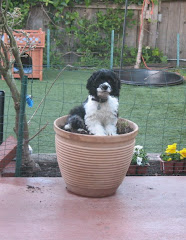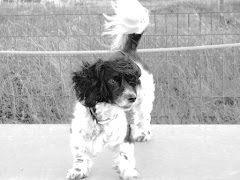While some dogs are fabulous at it right from puppy hood, others have to learn it from their puppy and adult counterparts - usually by making a mistake and not understanding the sign; and some just don't ever get it. It's something we, as humans, just can't teach them -- but you can help them out if you know what to look for, so you can guide your dog to behave in the proper manner when you see the signal. Remember to keep the leash loose and coach them through the greeting, so that your dog can probably greet and signal the other dog. Tight leashes cause frustration from your arm, all the way down the leash -- that's how "leash aggression" gets started.
I walk Harleigh off-leash in my neighborhood for a couple of reasons. 1. She is 8 years old and is under total voice control; 2. We meet oodles of puppies and obnoxious adolescent dogs on our walk -- this allows her to show them to keep their distance or calmly go around her (she isn't constricted by a leash or too close to me to interfere with any signals she is sending); 3. She is small and non-threatening to people and dogs; 4. She doesn't spook at trucks, fireworks, Blue Angels, etc. (that would be a definite safety issue requiring leashing).
A great example is the puppy in class playing who gives appropriate appeasement gestures. While it is being bullied by another puppy, the appeasing puppy simply lies on its back or side and doesn't move. Who is in control? -- it's the puppy lying down - not the bully. If the puppy lying down doesn't move, the bully usually gives up and retreats and finds someone else to tackle. The puppy lying down is controlling its environment and its interactions completely.
Another point, one day at Crissy Field, a large Husky came running from across the beach at full speed toward Harleigh, who was on the path. I was getting a little nervous, I admit but I cleared the way, so she was clearly seen by the oncoming dog. She calmly stood still and turned her head to the side. (Remember running, instigates a chase.) The Husky got to about 4 feet away, slammed on it's brakes when he realized what she was doing, and made a complete U-turn and ran the other way. That's an incredible dog that was able to read her body language and take appropriate action. I hope while you are at the park now, you will notice these kinds of interactions.
While you are working with your dog, look for signals like:
Yawning
Scratching
Lip Licking
These can be signs of frustration or confusion. While Turid Rugaas, noted author below, calls them calming signals -- there are many others who refer to them as displacement signals. Have you asked your dog to SIT, SIT, SIT, and when she finally does, she starts scratching behind her ear. Have you asked your dog to sit and stay at the curb, and they look at you and yawn. These are all signs that things are a bit difficult, please make it a little easier for me. Or I have done this so many times now and I am confused why are we still doing this. I don't like to put words coming out of a dog's mouth -- but those are the types of meanings behind those behaviors we see when training.
And just a reminder -- a wagging tail does not always mean happiness -- it is arousal and depending on the carriage of really high, high, medium to low, it can mean different things. Too much for me to go into -- but you get the idea. Same with hair raised on the back -- again it is arousal -- it's not necessarily a bad thing - and each dog is different as to how quickly it's hair raises and what causes it. An observant owner notices when this happens with their dog and comes to realize the causes.
Stay observant,
The Puppy Nanny
References:
Pictures from Turid Rugaas website: http://www.canis.no/rugaas/gallery.php
Turid Rugaas - "On Talking Terms with Dogs - Calming Signals" http://www.dogwise.com/itemdetails.cfm?ID=DTB527
Subscribe to:
Post Comments (Atom)



No comments:
Post a Comment